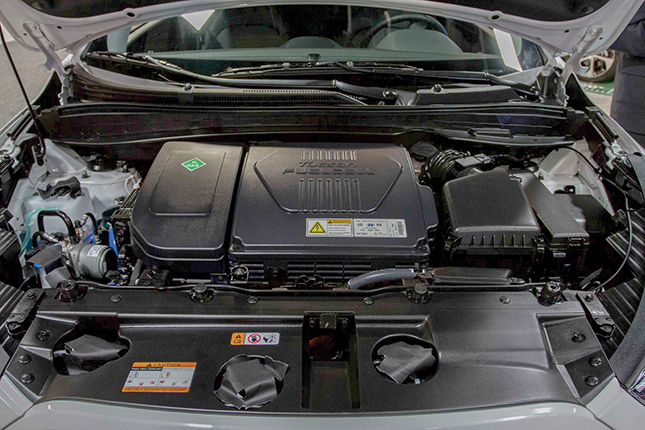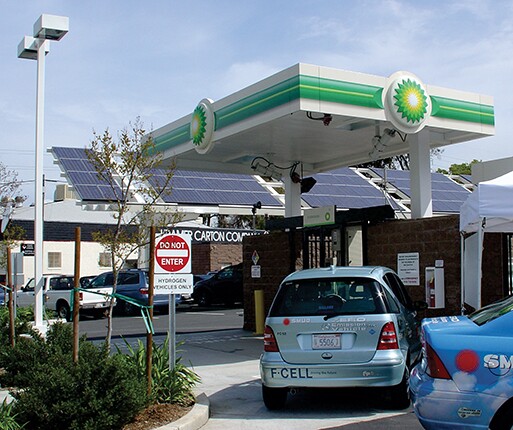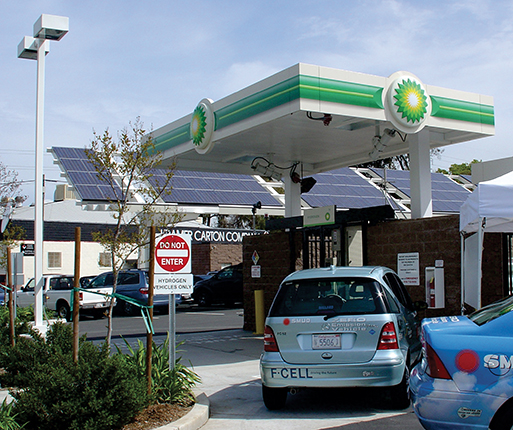Hydrogen-powered vehicles: A chicken and egg problem
DOI: 10.1063/PT.3.3690
Hydrogen is the ultimate clean fuel. Whether it is burned or chemically recombined with oxygen in fuel cells, the reaction produces only water and heat. (See the article by Joan Ogden, Physics Today, April 2002, page 69
Water, of course, contains a virtually endless supply of hydrogen, but considerable energy is required to break its chemical bonds through electrolysis or other technologies. Most of the hydrogen produced today is extracted from natural gas, which leaves behind carbon dioxide. Most of the 11 million tons of hydrogen produced in the US every year is used in oil refining, ammonia for fertilizer, and other chemical processes. A small but growing market for the light element is for fuel-cell vehicles.
Today’s commercial fuel cells are so efficient that even with natural gas as the hydrogen source, a fuel-cell vehicle produces only half the CO2 emissions of a gasoline-fueled vehicle of comparable power, after production and transportation costs for both fuels are considered. But the ultimate goal of CO2-free fuel-cells requires hydrogen generated from renewable energy. That’s the objective of the hydrogen and fuel-cell research program at the Department of Energy and its national laboratories.
Three manufacturers, Toyota, Hyundai, and Honda, currently offer fuel-cell vehicles for sale in the US, so far only in California. The cars are expensive: A Toyota Mirai lists for $57 500. Sunita Satyapal, director of DOE’s Fuel Cell Technologies Office, says agency-funded R&D has helped bring down the cost of vehicle fuel cells by 80% over the past decade, to a current estimated $45–$50 per kilowatt-hour of capacity for production runs of 500 000 units. That’s getting close to the $35/kWh that will make fuel-cell cars fully competitive with gasoline-powered vehicles.
Keith Wipke, program manager for fuel-cell and hydrogen technologies at the National Renewable Energy Laboratory (NREL), says the cost gap can be closed by further reducing the amount of platinum-group metals—platinum, ruthenium, rhodium, palladium, osmium, and iridium—required as catalysts on fuel-cell electrodes. Right now the precious metals are roughly half the total cost of fuel cells. The DOE program has set a goal to cut the metals content below the 8–10 grams contained in today’s automotive catalytic converters. Fuel-cell manufacturers closely guard the platinum-group content of their products, although General Motors in 2012 predicted that their platinum content would decline from 80 grams to 30 by 2015, and could fall to 10 grams before 2025.

The Hyundai Tucson, powered by a hydrogen fuel cell, emits only water. It is one of three fuel-cell car models for sale in California.
SIMON EDELMAN/DEPARTMENT OF ENERGY

One technology being explored at NREL to minimize platinum-group use is atomic vapor deposition, which can maximize the metals’ active surfaces. Meanwhile, ElectroCat, a consortium of four national labs, is exploring alternative materials for catalysts in fuel cells.
Progress on renewable hydrogen production has lagged well behind the advancements that have taken place in fuel cells. “Literally billions have been spent by government and car companies on fuel cells,” Wipke says. “Probably one-hundredth of that has been spent on electrolysis research.” Today’s commercial electrolyzers operate at very high current densities and must run constantly at high throughput to be economically viable, says Brandon Wood, a scientist at Lawrence Livermore National Laboratory. Cheaper catalysts would improve the economics of electrolysis powered by intermittent renewable energy sources. Cost considerations aside, platinum remains the catalyst to beat.
Platinum alternatives
Wood is a principal investigator of HydroGEN, a consortium of six national labs that is working to develop lower-cost catalyst alternatives for hydrogen production. He and coinvestigators just announced the discovery of new transition-metal catalyst candidates, tantalum disulfide and niobium sulfide. The materials have been shown not only to catalyze water splitting well but also to self-optimize their morphology so that their active sites are maximized as the reaction proceeds. That self-configuring feature, Wood says, means “you don’t really have to have a perfect material to start out with, you just need to get the ingredients in place.”

Hydrogen-fueled vehicles at a filling station in Sacramento, California. Hydrogen is produced on-site by electrolysis powered by solar panels.
KEITH WIPKE/NATIONAL RENEWABLE ENERGY LABORATORY

Although the materials offer performance “almost as good as platinum,” Wood says, the chemical vapor deposition process used to synthesize them in the lab is expensive and isn’t scalable commercially. Livermore scientists are considering making aerogel versions as a possible interim step toward commercial-scale production with an industrial partner.
Most of the R&D on alternative catalysts has focused on the hydrogen part of the water-splitting reaction, Wood says, and several good candidates have been identified. Considerably less research has been done on oxygen catalysts, which is a more complicated problem having fewer candidate materials. “The real bottleneck is on the oxygen side,” he says. “You can make your hydrogen evolution catalysts phenomenal and you’re still stuck with what you get on the oxygen side because that limits the reaction.”
At NREL, research efforts are beginning to shift from improving the process of removing water from electrolytically generated hydrogen to improving the durability and efficiency of water-splitting membranes and catalysts. That includes developing international protocols to rapidly measure the durability of electrolyzer materials. “We’re still figuring out what the degradation mechanisms are for electrolysis. Step one is to create tests that tell you when you have a good durable material,” says Wipke.
Photoelectrochemical cells, which use semiconductors to produce hydrogen from sunlight and water, are a less mature renewable technology. Although NREL set a record of 16% for photoelectrochemical efficiency this year, Wipke says the cells’ durability is an issue and commercialization is far off.
Other renewable production approaches include high-temperature electrolysis, in which heat from external sources such as nuclear reactors or from the Sun accelerates the reaction, and thermochemical electrolysis, in which high heat generated from sunlight drives hydrogen-producing chemical reactions. There are a number of biological approaches, including extraction from the methane generated at farms and landfills.
Infrastructure is lacking
The biggest impediment to widespread adoption of fuel-cell vehicles is only partly technological—namely, the need for a supporting fueling infrastructure. There are currently only 29 retail filling stations in the US, all located in California. Governor Jerry Brown has committed to providing cost-shared state funding for a total of 100 stations, which would help to create a regional market for the vehicles. For a station to qualify to receive state funding, at least one-third of the hydrogen sold at the pump must come from renewable sources. The industry has done better than that, notes Wipke; it currently derives 44% of the gas either from renewable-powered electrolysis or from biogas.
Although hydrogen from methane costs around $2/kg, prices at the pump are $10–$16/kg, reflecting the costs of transportation, compression, and storage. Filling stations can cost $2 million, two-thirds of which goes to compression equipment. Alternatives to today’s piston-driven mechanical compressors include metal hydride storage and electrochemical compression. As more stations get built, economies of scale are expected to bring storage and distribution costs down, says DOE’s Satyapal.
The optimal fueling infrastructure would be delivery under high pressure through networks of underground pipes, as with natural gas, says Satyapal. Some 2575 km of hydrogen pipelines already exist in the US. Expanding that network, however, would be expensive. For now, production at a central location and transportation as liquid or as a gas under high pressure is the usual practice.
One success story has been the adoption, by large warehouse operators, of fuel-cell forklifts to replace battery-powered versions. Some 15 000 fuel-cell forklifts are now deployed by companies including Amazon, BMW, FedEx, and Walmart, at facilities across North America.
Outside the US, the Japanese government is planning widespread adoption of fuel-cell vehicles over the next decade, as well as the deployment of millions of stationary fuel cells for electric power generation. In Europe, the European Commission and the private sector have spent a combined €1.5 billion ($1.8 billion) on cost-shared grants over the past decade for R&D and demonstrations of fuel-cell vehicles and hydrogen infrastructure. With backing from the German government, the world’s first hydrogen train is scheduled to begin transporting passengers next year. Its builder, France’s Alstom, says it has letters of intent from several German states to build 60 of the trains.
More about the Authors
David Kramer. dkramer@aip.org
